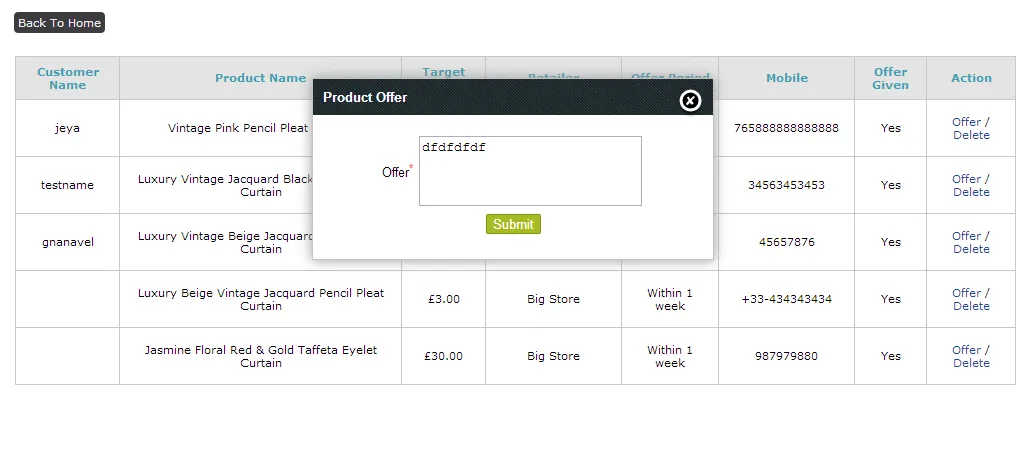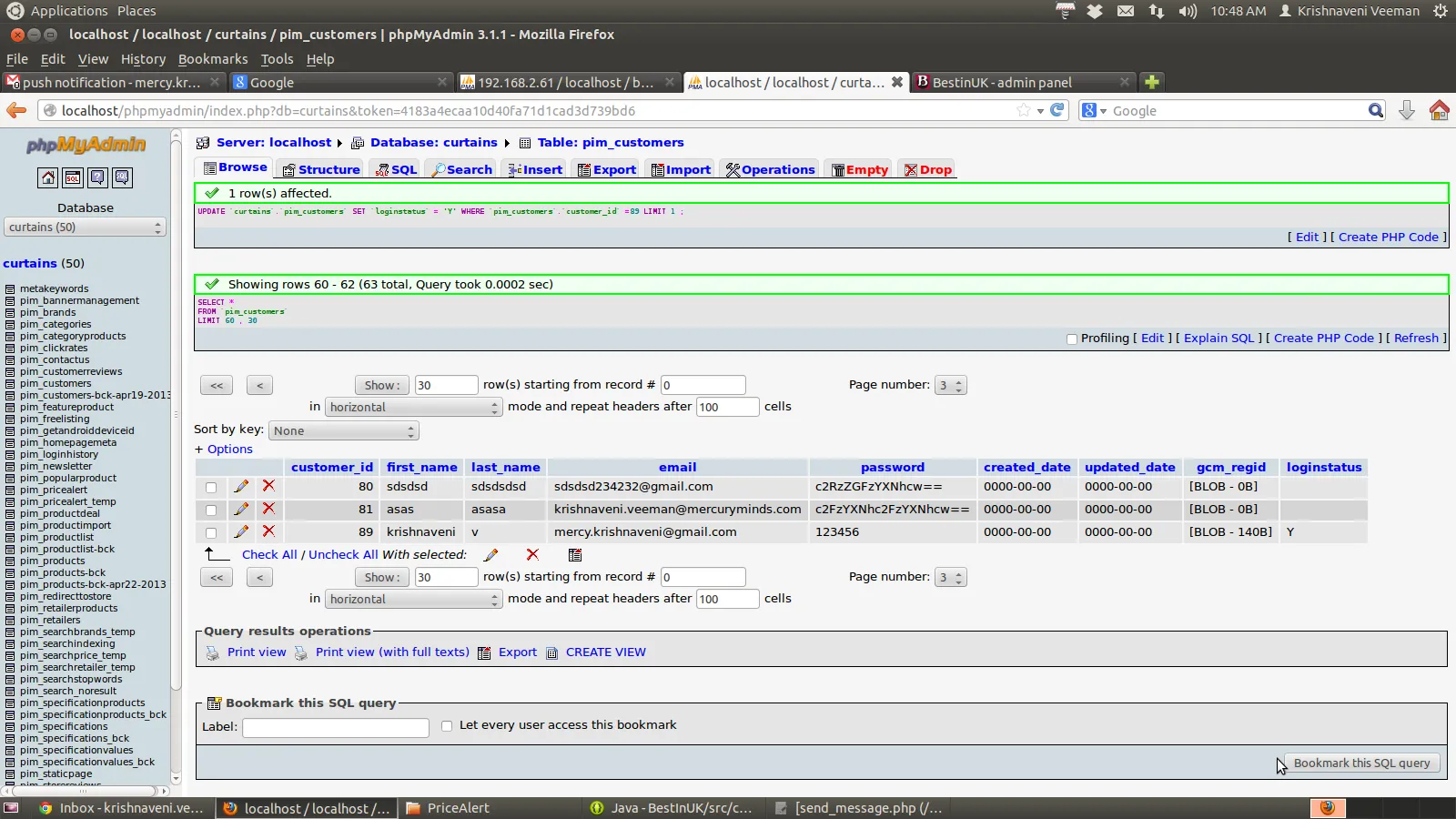我有以下两个问题:
第一个问题:
我必须为使用同一设备的两个客户注册,因此它们具有相同的注册ID。
当我从服务器端向这两个客户发送优惠时,显示的通知应该取决于已登录的客户。
例如(见图片):

 在我的应用程序中,我有一个客户登录表单。在这个表单中,如果用户
在我的应用程序中,我有一个客户登录表单。在这个表单中,如果用户gnanavel登录,应用程序必须只接收他的优惠,而不是其他人的优惠。
同样,如果用户jeya登录,应用程序必须只接收她的优惠,而不是其他人的优惠。
目前应用程序正在接收两种优惠。
编辑:
我在我的数据库中创建了登录状态字段。如果我的客户在设备上登录,那么它只会收到他的优惠通知,而不是其他人的。这很好地工作。
我在点击优惠按钮时检查条件:
$getregid = mysqli_query($con,"select * from pim_customers where customer_id='$customer_id' and gcm_regid='$regId' and loginstatus='Y'");
我编写了这些条件,意味着我的第一个问题已经解决。但是另一个问题出现了。 另一个问题是:
当管理员输入一些优惠信息时,只有当客户登录时才能在设备上收到通知。否则就不应该收到通知。这部分工作正常。
问题在于,当我的客户长时间未登录并且在此期间管理员输入了更多的优惠信息时。
如果客户在2天后登录应用程序,则应收到所有待处理消息。我如何获取待处理消息?
当管理员输入优惠时,如果客户已经注销,那么数据库中的登录状态为“N”。那么我该如何执行这些条件并接收通知呢?
$getregid = mysqli_query($con,"select * from pim_customers where customer_id='$customer_id' and gcm_regid='$regId' and loginstatus='Y'");
当点击“offer”按钮时,这是我执行的服务器端代码:
if (isset($_GET["regId"]) && isset($_GET["customer_id"]) && isset($_GET["message"])) {
$regId = $_GET["regId"];
$message = $_GET["message"];
$customer_id = $_GET["customer_id"];
include_once './GCM.php';
$getregid = mysqli_query($con,"select * from pim_customers where customer_id='$customer_id' and gcm_regid='$regId' and loginstatus='Y'");
$count1=mysqli_num_rows($getregid);
while($row = mysqli_fetch_array($getregid))
{
$id=$row['customer_id'];
}
if (mysqli_num_rows($getregid) > 0) {
$query = mysqli_query($con,"select count(offer) as count from pim_productdeal where customer_id='$id' and offer!=''");
$count = mysqli_fetch_array($query);
$msg = $count['count'];
$gcm = new GCM();
$registatoin_ids = array($regId);
$message = array("price" => $msg." "."The offers received");
$result = $gcm->send_notification($registatoin_ids, $customer_id, $message);
echo $result;
}
}
这是我的Android端代码:
public class GCMIntentService extends GCMBaseIntentService {
private static final String TAG = "GCMIntentService";
String regId;
public GCMIntentService() {
super(SENDER_ID);
}
@Override
protected void onRegistered(Context context, String registrationId) {
ServerUtilities.register(context, RegisterActivity.first_name, RegisterActivity.last_name, RegisterActivity.email, RegisterActivity.password, registrationId);
}
@Override
protected void onUnregistered(Context context, String registrationId) {
Log.i(TAG, "Device unregistered");
displayMessage(context, getString(R.string.gcm_unregistered));
ServerUtilities.unregister(context, registrationId);
}
@Override
protected void onMessage(Context context, Intent intent) {
Log.i(TAG, "Received message");
GCMRegistrar.checkDevice(this);
GCMRegistrar.checkManifest(this);
regId = GCMRegistrar.getRegistrationId(this);
String message = intent.getExtras().getString("price");
displayMessage(context, message);
if(Constants.response != null) {
generateNotification(context,message);
}
}
@Override
protected void onDeletedMessages(Context context, int total) {
Log.i(TAG, "Received deleted messages notification");
String message = getString(R.string.gcm_deleted, total);
displayMessage(context, message);
// notifies user
generateNotification(context,message);
}
@Override
public void onError(Context context, String errorId) {
Log.i(TAG, "Received error: " + errorId);
displayMessage(context, getString(R.string.gcm_error, errorId));
}
@Override
protected boolean onRecoverableError(Context context, String errorId) {
// log message
Log.i(TAG, "Received recoverable error: " + errorId);
displayMessage(context, getString(R.string.gcm_recoverable_error,
errorId));
return super.onRecoverableError(context, errorId);
}
private static void generateNotification(Context context,String message) {
int icon = R.drawable.icon;
long when = System.currentTimeMillis();
NotificationManager notificationManager = (NotificationManager)
context.getSystemService(Context.NOTIFICATION_SERVICE);
Notification notification = new Notification(icon, message, when);
String title = context.getString(R.string.app_name);
Intent notificationIntent = new Intent(context, MyDealProducts.class);
notificationIntent.setFlags(Intent.FLAG_ACTIVITY_CLEAR_TOP |
Intent.FLAG_ACTIVITY_SINGLE_TOP);
PendingIntent intent =
PendingIntent.getActivity(context, 0, notificationIntent, 0);
notification.setLatestEventInfo(context, title, message, intent);
notification.flags |= Notification.FLAG_AUTO_CANCEL;
notification.defaults |= Notification.DEFAULT_SOUND;
notification.defaults |= Notification.DEFAULT_VIBRATE;
notificationManager.notify(0, notification);
}
}